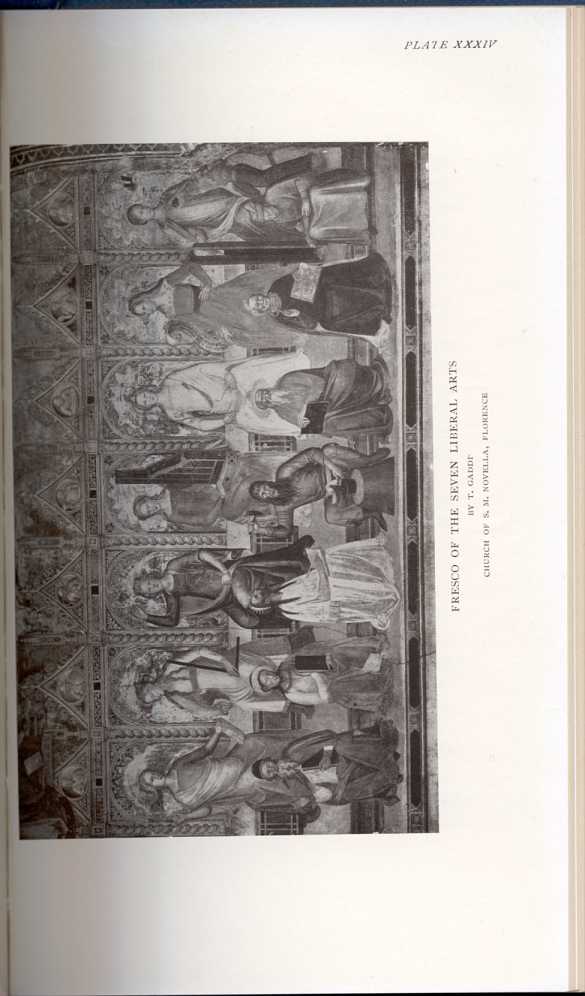| CHAPTER XI: THE CHARACTER OF THE MEDIEVAL LIBRARY, AND THE EXTENT
OF CIRCULATION OF BOOKS Old English libraries; the making, collection and use of books during the middle ages | ||
3. § III
On one occasion, after spending much time in searching wills and in examining catalogues without finding a reference to an interesting book—to either an ancient or a medieval classic the writer well remembers the little shock of pleasure he felt when, in a single half-hour, he noted Piers Plowman in one brief unpromising will, and six English books among the relics of a mason. Nearly all the libraries of private persons and of academies are depressing in character. Rarely can be found a bright human book gleaming like a diamond in the dust. Score after score of decreta, decretales, Sextuses, and Clementines, and chestsful of the dreariest theological disquisition impress upon the weary searcher the fact that academic libraries were usually even more dryasdust than monastic collections, and he begins to understand how prosperous law may be as a calling, and to have an inkling of what is known, in classic phrase, as a good plain Scotch education.
Between an academic library and a monastic collection there were
differences of character and in the beauty and value of the manuscripts.
As a general rule a large proportion of the monks' books were more or
less richly ornamented: they were the treasures as well as the tools of
the community. The books of the colleges were usually for practical
purposes: they were tools, treasured, doubtless, for their contents, not
for the beauty of the writing or because they were decorated. The
difference in character of the collections as a whole was one of
proportion in the
 [Description: FRESCO OF THE SEVEN LIBERAL ARTS BY T.
GADDI CHURCH OF S. M. NOVELLA, FLORENCE]
[Description: FRESCO OF THE SEVEN LIBERAL ARTS BY T.
GADDI CHURCH OF S. M. NOVELLA, FLORENCE]
Early university studies were in two parts, the trivium —grammar, rhetoric, and logic, and the quadrivium— music, astronomy, geometry, and arithmetic. These were the seven liberal arts. A fresco in a chapel in the Church of S. Maria Novella at Florence illustrates these arts. On the right of the cartoon is the figure of grammar; beneath is Priscian. For the study of this subject John Garland recommended Priscian and Donatus. Priscian was a leading text-book on the subject, and it was supported by a short manual compiled from Donatus. At Oxford extracts from these authors were thrown into the form of logical quaestiones to afford subjects of argument at the disputations held once a week before the masters of grammar. [11.35] To these books should be added a dictionary, with some peculiar and quaint etymologies, by Papias the Lombard; grammatical works by John Garland; Bishop Hugutio's etymological dictionary (c. 1192); a dreary hexameter poem by Alexander Gallus, the Breton Friar (d. 1240)—"the olde Doctrinall, with his diffuse and unperfite brevitie"; Eberhard's similar poem (c. 1212), called Graecismus, because it includes a chapter on derivations from the Greek; and a very large book, the
Humane, dure, large, firmeque, benigne,
Ignaveque, probe vel avare sive severe,
Inde rove, plene, vel abunde sive prolerve,
Dicis in er vel'in e, quamvis sint illa secundae,"
Learn these neuters nine by rote,"
Next to the figure of Grammar is Rhetoric, with Cicero
The first figure in the representation of the quadrivium is Music, with Tubal Cain beneath. In this subject, for which few books were necessary, Boëthius was the guide. With Astronomy is associated Ptolemy. The Cosmographia and Almagest of Ptolemy, and the works of some Arabian authors, with books of tables, were the student's manuals. In our cartoon Geometry has Euclid for companion. Arithmetic is associated with Pythagoras in the picture: for this subject Boëthius was the text-book. [11.37]
Besides the seven liberal arts, natural, metaphysical, and moral philosophy, or the three philosophies, were added in the thirteenth century. For these studies Aristotle and his
And Deiscoricles, and eek Rufus,
Old Ypocras, Haly and Galien;
Serapion, Razis and Avicen;
Averrois, Damascien and Constantyn;
Bernard, and Gatesden, and Gilbertyn."
Next to theology—in which class the chief books were the same as in the claustral library, although liturgical books are more rarely found—the largest section of an academic collection was that of civil and canon law. It comprised the various digests, the works of Cinus of Pistoia and Azo; texts of decrees, decretals, Liber Sextus Decretalium, Liber Clementinae, with many commentaries, the Constitutions of Ottobon and Otho, the book compiled by Henry of Susa, Cardinal Bishop of Ostia, called Summa Ostiensis, the Rosarium of Archdeacon Guido de Baysio, and Durand's Speculum Judiciale. The last three books are frequently met with, and were highly esteemed by medieval jurists.[11.38]
In a previous chapter we have noted the somewhat fresher character of the library given to Oxford University by the Duke of Gloucester. We have two later records which may be referred to now to indicate the change wrought by the Renascence. A catalogue of William
Still more significant of the change are the references to the course of study in the statutes of Corpus Christi College, Oxford (1517). The approved prose writers are Cicero—an apology is offered for the use of barbarous words not known to Cicero—Sallust, Valerius Maximus, Suetonius, Pliny, Livy, and Quintilian. Virgil, Ovid Lucan, Juvenal, Terence and Plautus are approved as poets. Suitable books to study during the vacations are the works of Lorenzo della Valle, Aulus Gellius, and Poliziano. In Greek the writings—most of them quite new to the age—of Isocrates, Lucian, Philostratus, Aristophanes, Theocritus, Euripides, Sophocles, Pindar, Hesiod, Demosthenes, Thucydides, Aristotle, and Plutarch are recommended. Such a list bears few resemblances to the academic library we have attempted to describe.[11.39]
| CHAPTER XI: THE CHARACTER OF THE MEDIEVAL LIBRARY, AND THE EXTENT
OF CIRCULATION OF BOOKS Old English libraries; the making, collection and use of books during the middle ages | ||